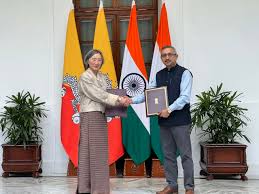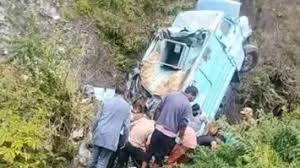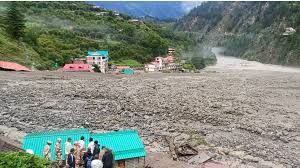India, Bhutan review development partnership

India and Bhutan, two Himalayan neighbors with deep-rooted historical, cultural, and diplomatic ties, recently held a comprehensive review of their bilateral development partnership. This partnership, among the most enduring and successful in South Asia, continues to evolve, reflecting the priorities of both nations—from infrastructure and energy to digital innovation and climate resilience.
A Bond Forged in Friendship and Mutual Growth
India has long been Bhutan’s largest development partner, supporting its journey from a Least Developed Country (LDC) to a Middle-Income Country. Over the decades, Indian assistance has powered Bhutan’s road networks, hydropower plants, hospitals, schools, and IT infrastructure.
During the review meeting held in Thimphu and co-chaired by senior officials from both countries, the focus was not only on celebrating past achievements but also charting a forward-looking agenda for the next phase of development cooperation under Bhutan’s 13th Five-Year Plan (2024–2029).
India’s ₹10,000 Crore Commitment
India’s financial commitment under the 13th Plan stands at ₹10,000 crore, a 100% grant-based support package that includes:
- ₹7,000 crore for Project Tied Assistance (PTA)
- ₹1,000 crore for High Impact Community Development Projects (HICDPs)
- ₹1,500 crore for Bhutan’s Economic Stimulus Programme
- ₹500 crore as general grants
This allocation is not just symbolic—it reflects India’s strategic intent to deepen Bhutan’s development while reinforcing regional stability and prosperity.
Project Implementation Gains Momentum
As of mid-2025, India and Bhutan have already approved:
- 61 PTA projects amounting to approximately ₹5,000 crore
- 283 HICDPs worth over ₹417 crore
A recent release of ₹250 crore under the plan underscores the commitment to timely and transparent implementation. These projects span sectors such as roads, bridges, healthcare infrastructure, education, digital connectivity, water supply, and disaster resilience.
Hydropower: Backbone of Economic Cooperation
Hydropower continues to be the cornerstone of India–Bhutan economic ties. Bhutan exports the majority of its hydropower to India, contributing around 40% of its national revenue. Jointly developed projects like Chukha, Tala, Kurichhu, Mangdechhu, and the soon-to-be-completed Punatsangchhu I & II are prime examples of cross-border infrastructure success.
Looking ahead, the focus is shifting towards cleaner and diversified renewables. Two recent agreements reflect this trend:
- Adani Group signed an MoU with Bhutan’s DGPC to explore up to 5,000 MW of clean energy collaboration.
- Reliance Power and Green Digital Holdings signed a long-term agreement for a 500 MW solar project in Bhutan.
These ventures mark a pivotal step towards transitioning from hydro-dominated generation to a balanced green energy mix.
Gelephu Mindfulness City: A New Frontier
One of the most ambitious initiatives discussed during the review is Bhutan’s plan to develop the Gelephu Mindfulness City, a futuristic economic zone near the Indian border. With an emphasis on sustainability, spirituality, and cross-border commerce, the city is envisioned as Bhutan’s gateway to South Asia and Southeast Asia.
India has pledged infrastructural support, including new road and rail links, to ensure seamless connectivity to Gelephu. The city could become a regional hub for investment, wellness tourism, clean-tech startups, and innovation-driven services.
Focus on Digital and Social Sectors
Beyond physical infrastructure, the partnership is deepening in education, health, space, and digital public infrastructure:
- India supported the construction of the Mother & Child Hospital in Thimphu
- Bhutan’s first law school was built with Indian aid
- RuPay and UPI have been integrated into Bhutan’s financial system
- India assisted in the launch of Bhutan’s satellite, helping the country harness space for development
These initiatives are creating long-term human capital and technological capacity in Bhutan.
Capacity-Building and Border Connectivity
India continues to support Bhutan through initiatives such as Project DANTAK, which maintains critical border roads and bridges. India is also investing in improving key border check posts, including Samdrup Jongkhar and the Integrated Check Post at Darranga, to facilitate trade and tourism.
At the same time, capacity-building programs and scholarships for Bhutanese civil servants, engineers, and students are fostering knowledge transfer and people-to-people connections.
Addressing Challenges with Mutual Respect
While the partnership is robust, both sides recognize the need to address some challenges:
- Project delays and environmental concerns in hydropower and highway construction must be addressed through better planning and local engagement.
- Bhutan’s growing exposure to international financing and global partnerships (such as investments from Singapore and the UAE in Gelephu) requires India to stay adaptive and responsive, ensuring its support remains relevant.
- Climate change impacts, especially on Bhutan’s glacial systems and river flows, require coordinated environmental safeguards.
A Strategic Alliance in a Changing Region
India–Bhutan relations go beyond transactional aid. They represent a shared vision of peace, prosperity, and sustainability in the eastern Himalayas. In an era of shifting geopolitics—marked by Chinese assertiveness and increasing regional competition—India’s support for Bhutan is a strategic investment in neighborhood stability.
Bhutan, under its visionary leadership, seeks to maintain its sovereignty and ecological identity while embracing global integration. India, as a time-tested friend, is positioning itself not just as a financier, but as a partner in Bhutan’s self-reliance.
Conclusion
The recent review of the India–Bhutan development partnership reaffirmed what both nations have always known—that friendship anchored in trust, respect, and shared aspirations can yield transformative results. As the 13th Plan gains momentum, the coming years promise new chapters of innovation, inclusion, and integration between the two countries.
Bhutan’s rise as a green, mindful, and connected economy—powered by India’s enduring support—could become a model for regional cooperation in the Global South.






